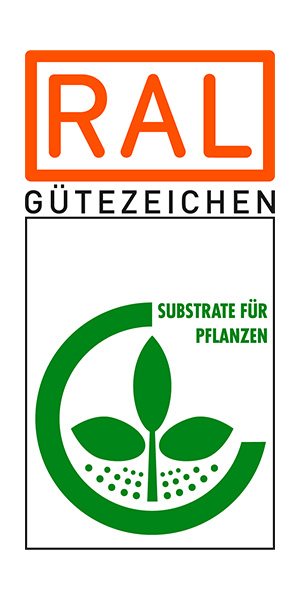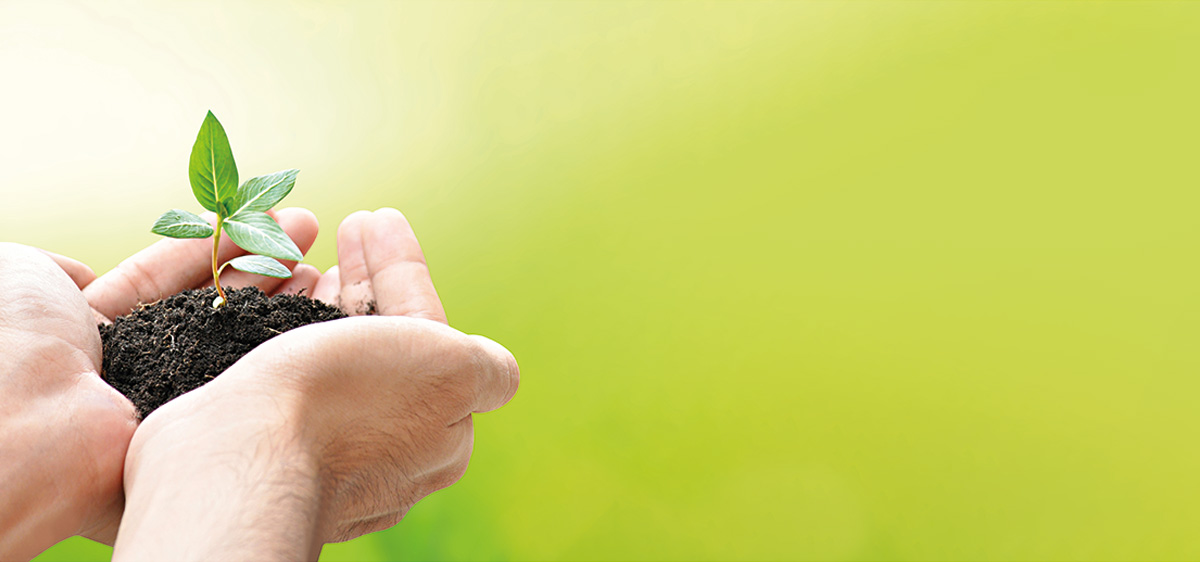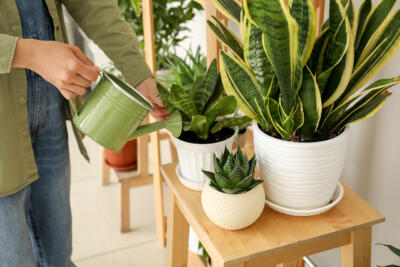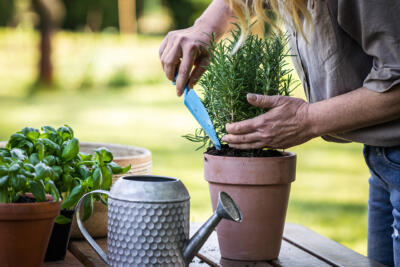Gardening with peat-free soil:
How to make the transition a success
For decades, peat was the main component in soil mixes (substrates) in both horticulture and amateur gardening, thanks to its many benefits. The new peat-free and peat-reduced soil mixes aim to replicate these ideal properties using alternative ingredients.
The quality of the constituents used – such as wood fibre, green waste compost, bark humus or coconut products – is especially important, as they affect nutrient supply and the substrate‘s pH value and plant compatibility. The combination of different peat substitutes also impacts the appearance and structure of the peat-free mixes, which tend to be lighter in colour and coarser than traditional peat-based substrates.
WHAT SHOULD I KEEP IN MIND WHEN USING PEAT-FREE SOIL?
WATERING
Ensure your plants receive enough water! Peat-free soil retains less water per watering than peat-based substrates. This is due to
the coarser structure and lower water retention capacity of the alternative ingredients. As a result, you will need to water more thoroughly
and, in very hot weather, possibly several times a day. As a general rule, the smaller the container, the more frequently you‘ll need to water.
Tip: In the tried-and-tested „finger test“, push your finger deeper than usual, as the surface of peat-free soil dries out much faster than its
deeper layers. This can give a false impression of the soil‘s actual moisture level. For smaller containers, you can also lift the container up
and feel its weight to check if it needs watering. A drainage layer of clay or pumice granules helps protect plants – especially those kept
outdoors – from waterlogged conditions after heavy rain or accidental overwatering.

FERTILISING
Due to the addition of compost, peat-free soil generally contains generous amounts of phosphorus and potassium. However, other constituents, such as wood fibre, tend to bind nitrogen, which is compensated for by adding nitrogen fertiliser during production.
Tip: Apply a nitrogen-rich liquid fertiliser early and regularly, or mix a nitrogen-rich slow-release fertiliser (e.g. horn grit, horn shavings,
of sheep wool pellets) into the planting hole when planting. Always follow the instructions on the fertiliser packaging.
POTTING

Peat-free soil often contains a large proportion of wood fibre, which will settle over time. After a few weeks, the soil surface may be lower
than the desired level.
Tip: When potting or repotting, remember that peat-free or peat-reduced substrates tend to settle more than you might be used to see
with peat-based soils. Fill containers almost to the rim, then press the soil down gently. Repeat this process until you reach the desired fill
level – but don‘t forget to leave a small watering edge!
STORAGE
Use peat-free or peat-reduced soil as soon as possible after purchase, as its properties can change over time. Always reseal opened bags
tightly and store them in a cool, dry and dark place to maintain quality.
WHAT CIRCUMSTANCES CAN ENCOURAGE THE DEVELOPMENT OF MOULD AND ODOURS?
If a warm and moist environment exists inside the packaging bag for a longer period of time, naturally occurring spores on organic materials may begin to germinate. These decomposers of dead organic matter can appear as a white web of fungal threads on the surface of the substrate. These fungi typically do not affect living plant parts.
Tip: The white web will disappear once the soil is loosened and used.
Odour may also develop in packaging bags containing organically fertilised soil („organic soil“). This usually indicates that the microorganisms have begun decomposing the organic fertiliser, which is necessary to make the nutrients available to plants.
Tip: To reduce the odour, slightly loosen the soil and leave it exposed to the air for three days. The odour will dissipate and won‘t return.
HAVE YOU EVER HAD PROBLEMS WITH FUNGUS GNATS?
Fungus gnats are small black flies that thrive in constantly moist soil. The more easily degradable organic matter the substrate contains, the more attractive it becomes to these pests.
Tip: To prevent infestation, always allow the surface of the substrate to dry out before watering again. Additionally, a 2 cm thick top layer of non-organic material (e.g. clay or pumice granules for indoor plants, vermiculite or silica sand for seedlings) will make it more difficult for fungus gnats to lay their eggs.
Click here for lots more practical information on soil mixes:
https://www.substrate-ev.org/en/consumer-info/
Gardening with peat-free soil:
How to make the transition a success
For decades, peat was the main component in soil mixes (substrates) in both horticulture and amateur gardening, thanks to its many benefits. The new peat-free and peat-reduced soil mixes aim to replicate these ideal properties using alternative ingredients.
The quality of the constituents used – such as wood fibre, green waste compost, bark humus or coconut products – is especially important, as they affect nutrient supply and the substrate‘s pH value and plant compatibility. The combination of different peat substitutes also impacts the appearance and structure of the peat-free mixes, which tend to be lighter in colour and coarser than traditional peat-based substrates.
WHAT SHOULD I KEEP IN MIND WHEN USING PEAT-FREE SOIL?
WATERING
Ensure your plants receive enough water! Peat-free soil retains less water per watering than peat-based substrates. This is due to
the coarser structure and lower water retention capacity of the alternative ingredients. As a result, you will need to water more thoroughly
and, in very hot weather, possibly several times a day. As a general rule, the smaller the container, the more frequently you‘ll need to water.
Tip: In the tried-and-tested „finger test“, push your finger deeper than usual, as the surface of peat-free soil dries out much faster than its
deeper layers. This can give a false impression of the soil‘s actual moisture level. For smaller containers, you can also lift the container up
and feel its weight to check if it needs watering. A drainage layer of clay or pumice granules helps protect plants – especially those kept
outdoors – from waterlogged conditions after heavy rain or accidental overwatering.

FERTILISING
Due to the addition of compost, peat-free soil generally contains generous amounts of phosphorus and potassium. However, other constituents, such as wood fibre, tend to bind nitrogen, which is compensated for by adding nitrogen fertiliser during production.
Tip: Apply a nitrogen-rich liquid fertiliser early and regularly, or mix a nitrogen-rich slow-release fertiliser (e.g. horn grit, horn shavings,
of sheep wool pellets) into the planting hole when planting. Always follow the instructions on the fertiliser packaging.
POTTING

Peat-free soil often contains a large proportion of wood fibre, which will settle over time. After a few weeks, the soil surface may be lower
than the desired level.
Tip: When potting or repotting, remember that peat-free or peat-reduced substrates tend to settle more than you might be used to see
with peat-based soils. Fill containers almost to the rim, then press the soil down gently. Repeat this process until you reach the desired fill
level – but don‘t forget to leave a small watering edge!
STORAGE
Use peat-free or peat-reduced soil as soon as possible after purchase, as its properties can change over time. Always reseal opened bags
tightly and store them in a cool, dry and dark place to maintain quality.
WHAT CIRCUMSTANCES CAN ENCOURAGE THE DEVELOPMENT OF MOULD AND ODOURS?
If a warm and moist environment exists inside the packaging bag for a longer period of time, naturally occurring spores on organic materials may begin to germinate. These decomposers of dead organic matter can appear as a white web of fungal threads on the surface of the substrate. These fungi typically do not affect living plant parts.
Tip: The white web will disappear once the soil is loosened and used.
Odour may also develop in packaging bags containing organically fertilised soil („organic soil“). This usually indicates that the microorganisms have begun decomposing the organic fertiliser, which is necessary to make the nutrients available to plants.
Tip: To reduce the odour, slightly loosen the soil and leave it exposed to the air for three days. The odour will dissipate and won‘t return.
HAVE YOU EVER HAD PROBLEMS WITH FUNGUS GNATS?
Fungus gnats are small black flies that thrive in constantly moist soil. The more easily degradable organic matter the substrate contains, the more attractive it becomes to these pests.
Tip: To prevent infestation, always allow the surface of the substrate to dry out before watering again. Additionally, a 2 cm thick top layer of non-organic material (e.g. clay or pumice granules for indoor plants, vermiculite or silica sand for seedlings) will make it more difficult for fungus gnats to lay their eggs.
Click here for lots more practical information on soil mixes:
https://www.substrate-ev.org/en/consumer-info/






